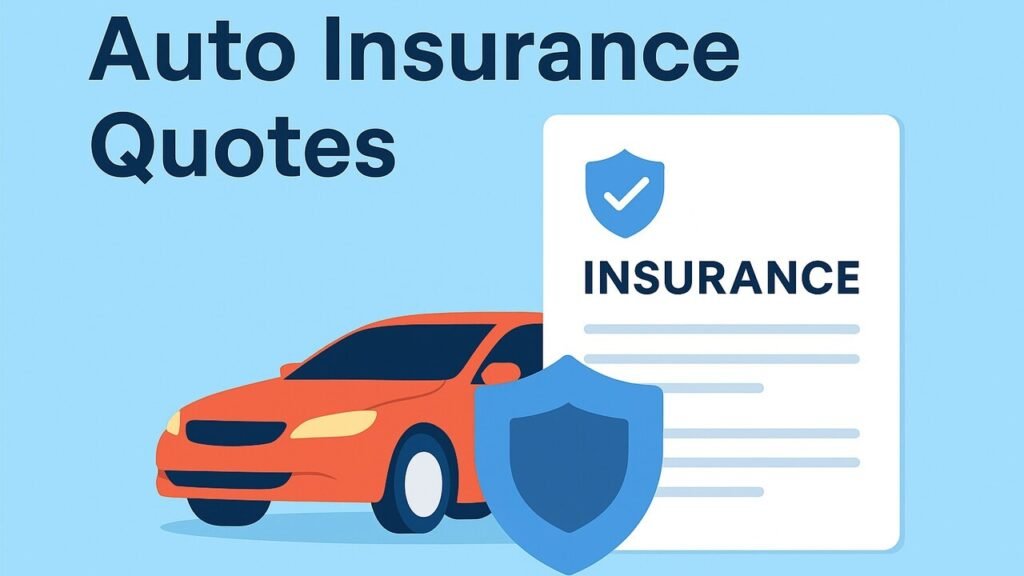Auto Insurance Quotes in the US: Every driver in the United States needs auto insurance—not just because it’s a legal requirement in most states, but also because it provides financial protection against unexpected accidents, damages, and liabilities.
One of the most common terms you’ll hear when shopping for coverage is an auto insurance quote. But what exactly does a quote mean, how is it calculated, and how can you compare different quotes to get the best value?
In this comprehensive guide, we’ll explain:
- Why auto insurance is important
- What an insurance quote includes
- How insurance companies determine your premium
- Strategies to compare and lower your quotes
- Common mistakes to avoid
Why Auto Insurance is Important
1. Legal Requirement
Most states in the US require drivers to carry at least minimum liability insurance. Driving without insurance can lead to fines, suspension of your license, and in some cases, legal action.
2. Financial Protection
Auto accidents can lead to thousands of dollars in repair bills, medical costs, and legal fees. Insurance ensures you don’t have to shoulder these expenses alone.
3. Medical Coverage
Some policies include personal injury protection (PIP) or medical payments coverage that helps pay for hospital bills after an accident.
4. Coverage Beyond Collisions
With comprehensive insurance, you’re covered for theft, fire, vandalism, or damage caused by natural disasters like floods and storms.
5. Required by Lenders
If you finance or lease your car, full coverage (liability, collision, and comprehensive) is usually mandatory.
What is an Auto Insurance Quote?
An auto insurance quote is an estimate of how much your policy will cost, based on your personal and vehicle information. It’s not a fixed rate—it can change once you officially apply, depending on additional checks by the insurer.
Factors That Influence a Quote:
- Driver Profile: Age, gender, and marital status
- Driving History: Accidents, speeding tickets, DUI charges
- Vehicle Details: Year, make, model, and safety features
- Location: ZIP code, city, and accident/theft rates
- Credit Score: Used in many states to assess risk
- Coverage Type: Liability-only vs. full coverage with add-ons
- Annual Mileage: More miles driven = higher risk
How to Read Auto Insurance Quotes
When you request a quote, you’ll see multiple components. Understanding these is crucial:
- Premium: The total cost of your policy (monthly or annually).
- Deductible: The amount you pay out of pocket before insurance covers damages.
- Liability Coverage: Protects against injuries and damages you cause to others.
- Collision Coverage: Pays for your car’s damages after an accident.
- Comprehensive Coverage: Covers non-collision incidents like theft or fire.
- Add-Ons: Extras like roadside assistance, rental car reimbursement, or gap insurance.
👉 Always compare quotes with similar coverage limits—don’t just pick the cheapest option.
Example of an Auto Insurance Quote
Premium: $145/month
- Liability: $100,000/$300,000/$50,000
- Collision: $500 deductible
- Comprehensive: $250 deductible
- Add-ons: Roadside assistance + rental car coverage
This breakdown shows exactly how your monthly cost is distributed across different protections.
How to Compare Auto Insurance Quotes
- Check Coverage Limits: Ensure all quotes include the same liability and coverage options.
- Review Deductibles: A lower premium may mean higher deductibles.
- Look for Discounts: Ask about multi-car, safe driver, or student discounts.
- Evaluate Company Reputation: Research claims service and customer reviews.
- Annual Reviews: Compare quotes every year to avoid overpaying.
Tips to Lower Your Auto Insurance Quotes
- Bundle Policies: Combine home and auto insurance with the same provider.
- Drive Safely: Tickets and accidents raise premiums significantly.
- Improve Credit Score: In states where it applies, better credit = lower rates.
- Choose Higher Deductibles: If you can afford them, your premium decreases.
- Install Safety Features: Anti-theft devices and airbags can reduce costs.
- Take Defensive Driving Courses: Some states give discounts for certified courses.
Common Mistakes to Avoid
- Choosing the Cheapest Quote Only: Low premiums often mean minimal coverage.
- Ignoring Exclusions: Always check what isn’t covered by your policy.
- Not Updating Policies: Moving, buying a new car, or adding drivers should trigger a review.
- Skipping Comparison Shopping: Staying with one insurer for years may cost you extra.
Frequently Asked Questions (FAQ)
Q1. What is the average cost of auto insurance in the US?
On average, full coverage costs $1,600–$2,000 annually, while minimum liability averages $500–$700.
Q2. How often should I get new quotes?
At least once a year, or after life changes (new car, new city, marriage).
Q3. Do credit scores affect insurance?
Yes, in many states insurers use credit to determine risk. Higher credit usually means lower rates.
Q4. Can I switch insurance providers mid-policy?
Yes, you can cancel anytime, and most companies will refund the unused portion.
Auto insurance is more than just a legal requirement—it’s a critical safety net that protects your finances and well-being. By understanding how auto insurance quotes are calculated, learning how to read them carefully, and comparing multiple providers, you can find the perfect balance of affordability and protection.
Remember: The cheapest policy isn’t always the best. Look for one that fits your budget while providing strong coverage, so you can drive with confidence knowing you’re protected.





